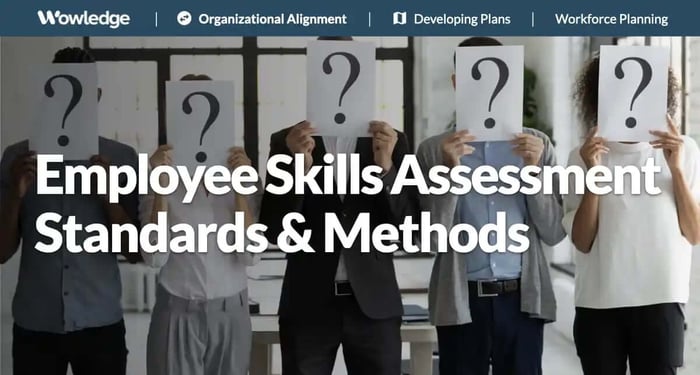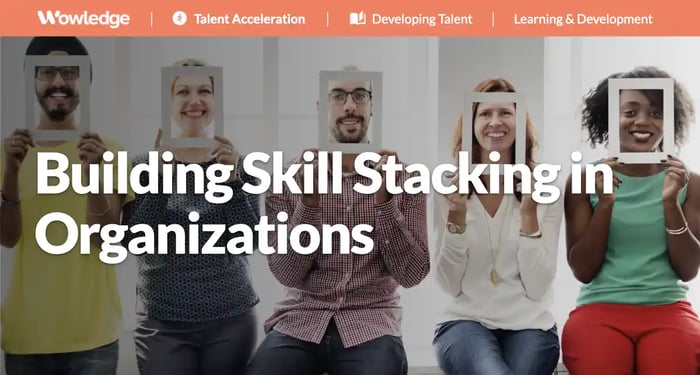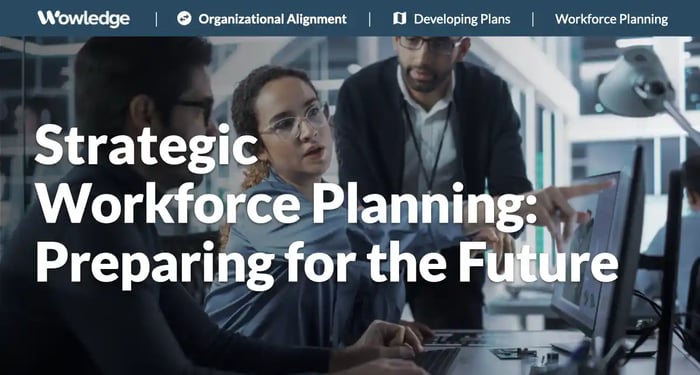Table of Contents
- Defining skills and their assessment
- The foundational elements of an employee skills assessment strategy and ecosystem
- Applying skill assessments across the employee lifecycle
- Knowing what to measure
- Skill assessment methods
- Technological advances that are changing how skills are identified and assessed
- Cautions with the use of skill identification and assessment tools
- Relevant Practices & Tools
- About Wowledge
In recent years, skills-based HR practices have become a hot topic in the business and HR press, primarily due to shrinking talent pools and college enrollments globally. Industry estimates have corporate adoption of skills-based hiring at rates as high as 81% of employers, focusing on skills assessments over college degrees as a proxy for candidate selection purposes. Similarly, skills-based development has taken hold as a primary strategy for ensuring that employee training and development offerings and activities address talent gaps that used to be filled primarily through recruiting and less-targeted learning. The challenge that emerges from this is the question of what foundation is used for employee skills assessment and identification.
Research from Deloitte found that only 17% of organizations feel confident about predicting future skills needs, and just 16% have adopted strategies to train on near-term skills needs shortly. Part of the challenge likely comes from organizations lacking a strong foundation for identification and employee skills assessment. Creating a skills-based talent ecosystem requires a sequence of steps, many of which can be accomplished by adopting existing and emerging databases and technologies that support the identification of skills that candidates and employees claim to possess and that have varying levels of evidence to support. However, identifying and assessing employee skills is a more complicated journey and a critical element in using them in decision making at the individual, team, function, and enterprise level.
Defining skills and their assessment
Employee skills assessment strategies start with consistently characterizing skills and their definition across the organization. As many organizations mix and match terminology, including terms such as talents, proficiencies, competencies, knowledge, abilities, capabilities, and other variations, establishing a baseline definition for use in employee skills assessment is paramount.
Merriam-Webster defines a skill as:
- The ability to use one's knowledge effectively and readily in execution or performance, or dexterity or coordination, especially in the execution of learned physical tasks.
- A learned power of doing something competently: a developed aptitude or ability.
Industrial/Organizational Psychologists define skills as the “observable and measurable abilities a person possesses, reflecting their capacity to perform tasks effectively in a workplace setting.” They further break those down into two primary types: technical competencies (functional expertise) and soft skills (interpersonal and behavioral), two major categories required for successful job performance.
The takeaway is that skills are observable and measurable extensions of an individual’s knowledge, are often based upon preexisting or naturally occurring strengths, and can be acquired and refined.
Identifying and assessing employee skills generates an understanding of an individual’s knowledge, abilities, and proficiency related to the skills needed to successfully perform all tasks required to perform a specific job or function. Employee skills assessment methods include tests, simulations, interview explanations, or demonstrations (actual or virtual) to assess an individual’s competence.

The foundational elements of an employee skills assessment strategy and ecosystem
Organizations should establish the necessary building blocks for employee skills assessment before embarking on a comprehensive skills-based talent or HR process. While pre-built skills databases and employee skill identification technologies are available on the market, defining the skills and their component elements and creating a standardized structure for objectively understanding the proficiency level are essential.
The goal of objectivity that skills-based approaches promise relies upon an alignment and agreement by job experts (leaders, line managers, compensation, and HR professionals) regarding observable and measurable standards. The challenge lies in having definitions of skills that every observer can reliably agree upon for fairness and consistency in evaluating candidates and employees across the organization, its various functions, locations, business units, and departments. As such, four foundational elements should be considered and included in any skill assessment process.
1. Clearly stated criteria to assess the presence of skills
The first question to be answered is, "How do I know if an employee possesses the skill?" This calls for having each skill defined in a measurable and observable manner by articulating its core knowledge and actions or behaviors, and understanding that an individual is capable and has experience or demonstrations of professional or industry-standard approaches to job tasks. This can also involve performing or completing the minimum required steps, techniques, or processes, or making decisions using appropriate tools, methods, and considerations.
2. Defined standards for differing levels of expertise to assess skills proficiency
The following foundational element assesses “How well can they perform the skill, how quickly or efficiently, in how wide a range of various circumstances or applications?”.
This calls for defining what is expected at each level of expertise, including the breadth and depth of skills. Questions such as how much independence an individual can be allowed when performing, how advanced the issue or challenge is that they can be assigned to handle, and to what extent they can guide others. Evaluating this allows for an understanding of the extent to which an employee properly applies standard or leading practices and processes consistently and effectively across circumstances, and effectively alters approaches based upon the unique needs of the situation.
These can be clarified in a professional body of knowledge (BoK) articulated by a professional association (e.g., HR, project managers, psychologists, Bankers, realtors) or credentialing organization (medical boards, lawyers, professional engineers, architects, teachers, accountants, pilots, etc.). Those are comprehensive, documented, and widely accepted listings of knowledge, abilities, and competencies required for minimum success in a given profession. They create standards that all professionals seeking their credentials must attain, maintain throughout their career in that field, and live by to continue to hold the credential or licensing.
3. Assessed for job-relatedness
A critical foundational element to any employee skills assessment approach is verifying the required skills as job-related. Given that one of the most valuable purposes of employee skills assessment is to support employment and career-related decisions (e.g., hiring, rating performance, promotion), the extent to which the skills are, in fact, crucial to successful job performance is a paramount concern. Two primary (and one related) considerations generate greater objectivity when used to authenticate the skills as job-related:
- Validity is a statistical method for determining how accurately the assessment method, tool, or process evaluates what it is designed to measure.
- Reliability uses statistical means to evaluate how consistently the assessment method, tool, or process measures the skill and its components across evaluators, testing environments, populations, etc.
- Fairness is the desired outcome of validity and reliability, or the extent to which any individual who objectively possesses the defined knowledge, skills, and competencies can understand and respond to the questions or directions in the assessment. This relates to the lack of language or cultural biases, unreasonable time limits, non-job-related physical requirements, or test scoring and interpretation actions that might limit or inhibit the success rates of otherwise appropriately skilled test-takers.
4. Progressive stages of expertise
This is a way to define how skill proficiency and competence levels progress or accumulate into increasing echelons of expertise, allowing for individual comparisons for deployment and development purposes. Commonly used in the skilled trades (Apprentice, Journeyman, and Master), these create a standard by which individual skill presence and precision can be consistently defined and applied across organizational functions and business units. Four or even five proficiency levels can be used, but each skill requires demonstrable and measurable behavior levels defined for consistent application.
Applying skill assessments across the employee lifecycle
The value of employee skills identification and assessment approaches becomes apparent when considering the range of talent applications they can impact. To make human work behavior and capabilities more objectively defined, assessing individual skills' presence and proficiency level creates a more robust, equitable, and efficient starting point for understanding employees' strengths across the spectrum of organizational roles and functions. Consider the cost of a poor or inaccurate hiring or promotion decision, the potential to miss out on developing and engaging a future high-potential leader, or placing an under-skilled sales or customer-facing professional in a business-critical situation.
The applications of skill-based employee assessments include:
- Evaluating candidates’ suitability and readiness to fill a job
- Assigning employees for placement on a project team
- Assessing employee performance against job standards
- Gauging employee development requirements
- Matching employees to career mobility opportunities
- Identifying well-suited and skilled employees for future people or process leadership roles
- Identifying the volume and location of employees against emerging skill requirements
Beyond the individual assessment, aggregated skills data has larger impacts when it is available to HR strategy, workforce planning, learning and development, and talent strategy teams.

Knowing what to measure
Two elements essential to understanding when identifying and assessing employee skills are the nature of the skill being assessed and the categories or types of skills to be evaluated. Consider these when designing a strategy for skills assessment, as they will impact 1) who is being evaluated, 2) when or at what point in the employment relationship the evaluation is made, and 3) why, or for what purpose, the assessment outcomes will be used.
The nature of skill possession reveals a status and timeframe of employee skill levels. It considers a skill’s potential (is it an existing aptitude, natural ability?), preexistence (does the employee have their base skill level from education, prior jobs, or life experiences?), or presence (does the employee possess it due to a need to apply it to perform the current role or has been observed practicing it?). The nature of a skill guides who, when, and why the skill's data can be collected.
Defining what to measure is also essential, as it links core skills needed for successful job performance and business needs, and supports a solid foundation for compensation, classification, recruiting, development, programs, frameworks, and HR planning activities. It helps identify the methods and tools needed to assess various types of skills. It can also be used to support a targeting of essential or differentiating (performance or potential) skills when exhaustive skills data collection methods may be out of reach from a cost, technology, or staff resources standpoint. Bringing those purposes together, blending the nature and what to measure yields primary use cases:
Potential job skills are innately, naturally occurring or developed strengths created by use and reinforcement during formative years in formal education (K-12, vocational, college, or graduate studies). While they certainly can be developed and refined, the ingrained potential to develop those gives the individual a leg up. They include required skills that apply directly to successful role performance, such as:
- Mental or behavioral abilities: cognitive ability, verbal reasoning, numerical reasoning, spatial reasoning, mechanical comprehension, situational judgement, abstract reasoning, logical reasoning, etc. They can also incorporate emotional intelligence, compassion, patience, resilience, and resourcefulness.
These are used in identifying future leaders, critical skills role holders, predicting who is best suited for developing needed skills, and those likely to adopt new skills, combined with existing ones, will qualify for emerging or critical roles. They are often helpful in identifying those who might not be otherwise seen or promoted by their managers, who have the potential to be great leaders, salespeople, product or customer development experts.
Preexisting or present job skills are those that have been developed and practiced in practical applications or circumstances, most frequently in current or previous job roles. The key here is that many companies cannot identify or lack awareness of skills developed and refined in jobs, internships, or other experiences with prior employers, extracurricular activities, or community (e.g., volunteer) experiences. While skills used and developed with the current employer are accessible to talent planners and deployment managers, those from previous experiences are often locked up and hidden in the originally submitted resumes, job applications, and interviewer notes. Examples of these job skills include:
- Technical (coding, systems administration, accounting, statistical, medical diagnosis), cognitive or intellectual (critical or integrative thinking, problem solving, research, analytical), administrative (project management, process design and management, “soft” or interpersonal (communication, collaboration, negotiation, presentation, conflict resolution), and personal work-related (adaptation, resilience, continuous learning, managing ambiguity).
Skill assessment methods
Employee skills assessment can rely on various options commonly used in assessment processes. They range in the strength of providing objective proof of the presence and extent of an individual’s skill in a given area of professional competency. Each serves as a potential insight into an employee’s skills and is often used most effectively when combined for multi-source assessment strategies. Multiple methods increase the confidence level for decision makers, as a mix of formal, statistically-derived assessments with in-person expert observations takes advantage of the measurable with the “I’m from Missouri, show me” bias that many leaders display and act upon.
1. Self-assessment
Involves employee self-report, such as on a candidate’s resume, a transfer applicant’s employee profile, a functional or leadership competency model template, an internal skills database response form, or a talent marketplace profile format.
2. Credentials
An objective proof of capability provided through badges, certifications, or diplomas vetted by external expert sources using more reliable industry standards. These can be based on a body of knowledge (BoK) validated and promoted as professional standards by licensing or industry associations.
3. Formal, structured, standardized tests
These tests are offered by third-party skills testing organizations and companies and used in educational, certification programs, and pre-employment activities. They are often validated across test takers from many companies, industries, and geographies.
4. Interviews or presentations
Candidates or employees are asked to explain how, when, and what they learned while performing a skill, typically to an expert, peer group, or evaluation panel. The ability to articulate what one knows is a stage of knowledge acquisition.
5. Classroom or online learning-embedded
Knowledge tests and skill evaluations that are integrated into learning environments to confirm concept absorption and application, measuring skill acquisition and associated achievement levels.
6. Performance-based demonstrations
Live or virtual simulations produce observable and measurable evidence of skill presence and proficiency level. These are often staged as work-sample tests or “chalk talks” (how would you solve this problem) and are a powerful opportunity to generate “proof” of difficult-to-fake skills.
7. Portfolios
Documented examples of completed work that exhibit a clear understanding, application, and level of mastery of a skill or knowledge. Consider classic portfolios of professionals in architecture, advertising, software developers, graphic designers, or project summaries or presentation decks used by consultants, marketing, and communications professionals.
8. Performance evaluations
Quantitative outcomes (e.g., sales, budget, client ratings) and managers' observations and judgments of third-party (internal or external) sources who supply insights on skill presence and proficiency from project feedback, performance check-ins, customer, or peer feedback. These may also include valuable leadership, functional, or employee competency model ratings that rely upon observations of the use and frequency or application of critical skills and abilities.
9. Social and collaboration platform contributions
Posted articles, comments, suggestions, and feedback in digital environments demonstrate the presence, level of proficiency, and range of experience in a specific skill or capability.
10. Expert observations
Valuable insights and direct experiences from others who have watched, experienced, analyzed, and judged an individual’s current and past demonstrations of the assessed skills. These might include reference checks with previous supervisors, employees and peers (in a 360-degree assessment), or from interviews and interactions during presentations of how skills were exhibited previously.

Technological advances that are changing how skills are identified and assessed
Significant advances have been made in how companies identify and assess employee skills. Aside from employee profiles, which are standard in many HR and career development-related systems, more exciting and mostly automated options have emerged that allow employees to identify and self-assess their skills.
Many recruiting, career management, internal talent marketplaces, learning management (LMS) systems, and modules have a built-in proficiency framework and collection capability. Skills assessment platforms that offer skills and occupation-based testing (e.g., TalentGuard, TestGorilla, HackerRank, Codility, eSkill, DevSkiller) provide capabilities for assessing proficiency or competence in a wide range of skills.
The newest and to many, most promising technologies are AI-supported or generated, such as those with skills-inference agents that automatically pull data from employee applications, resumes, skills databases, performance reviews, collaboration platform postings, and even their external social media profiles and posts. Some systems are designed principally as skills technology platforms. In contrast, others offer a range of capabilities, designed as intelligent agents for identifying and assessing employee skills, while providing insights and organizational skills management capabilities. Those are embedded in skills platforms and broader ERP, HR, and talent management systems.
Cautions with the use of skill identification and assessment tools
Many assessment options exist, but as with any strategic direction or purchase decision, caution needs to be exercised. The extent to which these tools and methods are mainly used to make employment-related decisions, specific measures should be taken to preserve their promise, value, and fairness to the company and its employees.
First and foremost, policies and procedures must be implemented to protect the security and integrity of employee data and personally identifiable information (PII). Aside from shielding the data from prying eyes and hackers, respect employee privacy by installing “need to know” standards when identifying those with data access.
Secondly, any tool or assessment technique that results in or drives an employee selection or differentiation process must be formally and statistically validated before being used for employment-related decisions. This is especially crucial for making and ultimately defending hiring, promotions, raises, or inclusion in HiPo or critical workforce segments subject to better pay, development, advancement, succession, and other opportunities. Their use for project assignments, company-wide skill gap assessments, and learning and development recommendations, while still best validated, poses less of a risk.
Do not rely upon vendor claims of “validation,” even when they state that their assessments are developed from thousands or millions of responses or job holders. This caution comes from an understanding of reliability and fairness standards. While some assessments and platforms are based upon vetted industry standards or professional bodies of knowledge, most others are based upon the scores of employees across many organizations with different outcome standards. In other words, what makes a great leader in one company, a highly productive software engineer in another, or a successful project manager in another, cannot accurately evaluate candidates from those jobs in a different organization.
Relevant Practices & Tools
Emerging Workforce Planning Practices that Drive Broader Skills-based and Future-focused Staffing Projections. >
Emerging workforce planning focuses on the future with a highly refined level of detail, moving the analysis from roles and critical segments to specific skills that aggregate into organizational capabilities... more »
Establishing a Robust Methodology for Job Descriptions and Evaluations Across the Organization. >
Job descriptions and evaluations are critical components to defining any compensation strategy. While job descriptions can be found on a significant variety of templates... more »
Auto-generating Career Opportunities by an AI Technology-driven Talent Marketplace. >
Talent or Opportunity Marketplace systems are Artificial Intelligence (AI)-enabled software that have varying capabilities, but primarily match employee data to job requirements... more »
Planning Individually Tailored Development for all Identified Successors and HIPOs. >
Once successors and HIPOs for critical roles are approved by top leadership, preparing those individuals for development planning is essential... more »
The Skills Taxonomy Tool: Define and Organize Job-relevant Skills Used in Different Jobs Across a Company. >
A tool to categorize and define the abilities needed to perform jobs across the enterprise. It is a catalog that can be used in collecting and assessing the individual and aggregate availability of skills... more »
About Wowledge
Wowledge is the implementation-first platform designed for lean HR teams and consultants who need to design and scale strategic HR programs efficiently—without starting from scratch.
Our members gain access to continuously updated best practices, step-by-step guidance, expert-built tools, and customizable templates—all structured to accelerate the development and implementation of key HR programs.
Recognizing that every organization operates at different levels of sophistication, Wowledge’s scalable system of best practices follows a stage-based approach—Core, Advanced, and Emerging—ensuring HR professionals can implement solutions tailored to their organization’s unique needs and goals.
Your Shortcut to Amplifying HR Impact!
Get started for FREE! Learn more.










